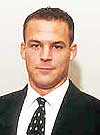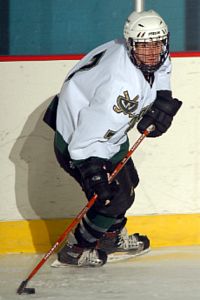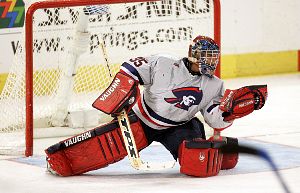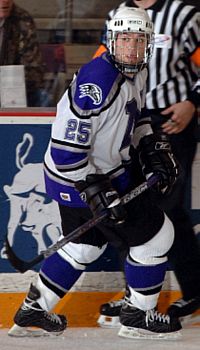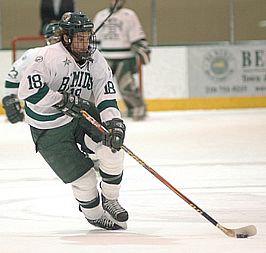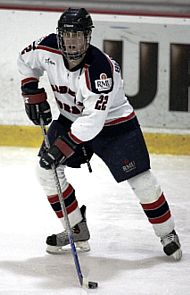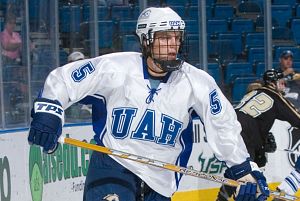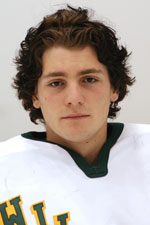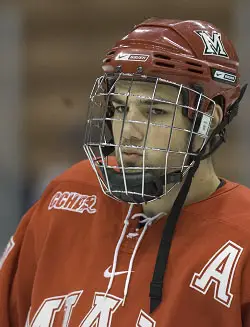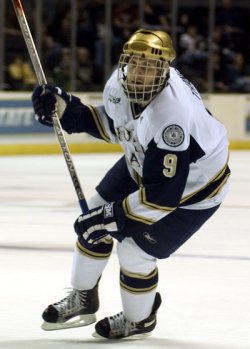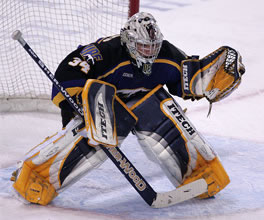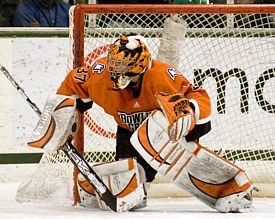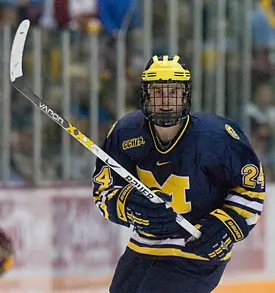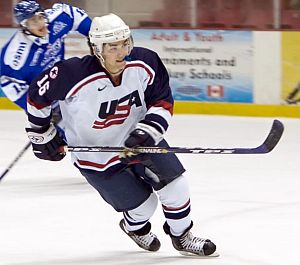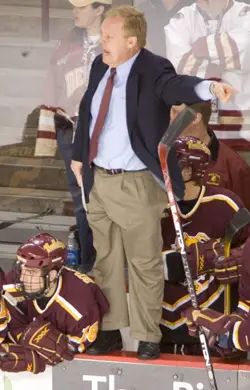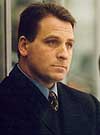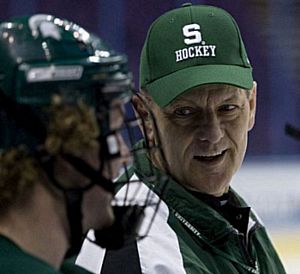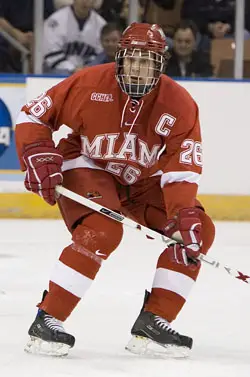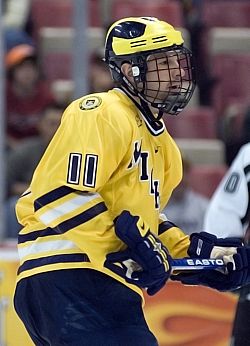As much as teams hate them, it seems like they’re going to have to get used to them.
Early departures.
“We lost another dozen players during the offseason to the National Hockey League,” said Doug Spencer, the WCHA’s associate commissioner for public relations. “Over the last two years, over 30 underclassmen have left early.”
This means, of course, that once again, the league is extremely young — 58% of players this year are freshmen and sophomores.
“The early signings are really becoming a concern; we didn’t quite know what was going to happen after the [NHL’s Collective Bargaining Agreement],” agreed league commissioner Bruce McLeod. “It’s some things that have changed in the American League … it’s not just one thing that has caused this phenomenon for us.”
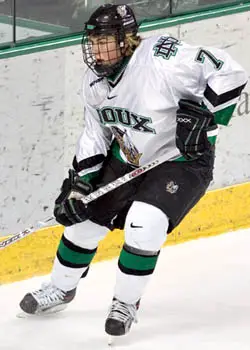
North Dakota’s T.J. Oshie is one underclassman who didn’t take the NHL bait during the offseason (photo: Melissa Wade).
As a result, coaches have had to shift their recruiting tactics to keep up.
“It certainly makes our jobs more difficult,” said Wisconsin head coach Mike Eaves. “We have to ask ourselves, the question is, ‘Is this young man a one-year, two-year, three-year, four-year player,’ and you’ve got to have that high-level player in your system in order to give yourself a chance to win.
“But it is the world in which we live so we have to have plan A, B and C laid out there in case these young people go.”
Expansion and the Future of College Hockey
Though the WCHA confirmed its moratorium on expansion in early May, much of the talk was nevertheless about expansion — especially given the recent news of Wayne State dropping its program.
“I think all of the coaches would tell you to a person that we want to see college hockey grow and what’s best for college hockey,” said Minnesota State University head coach Troy Jutting, “but we kind of have to let the people that are in the position to make those decisions make those decisions.”
The question of Bemidji State, a constant query for the league, did come up as well, given that the Beavers are one of the four remaining CHA teams.
“Bemidji’s had hockey for an awfully long time and we obviously have a good league and there’s going to be a lot of questions asked,” said Minnesota head coach Don Lucia. “The more people you let into a league, the less people are in other people’s buildings and I know people get upset about that.
“I think we still have to look and try to maintain the schools that we have, but also I think we have to try to find a way to maintain that sixth conference some way, somehow.
However, he added that, “it’s too early and there’s too much dialogue to be talked about to even go down that path.”
Filling the Holes
While the question for many teams last year was how to replace scoring, several teams have their question marks in arguably the biggest areas: defense and goaltending.
The WCHA saw seven starting goaltenders leave, six to graduation. The goaltender departure that will arguably hurt the most is Bobby Goepfert’s graduation from St. Cloud State.
“I think we’re probably one of the teams in the league that’s set with the most unknowns right now, especially for the defensive side, losing that goaltender and we’ve got one goalie coming back that’s played all of six games, another redshirt and a new freshman in there,” said SCSU coach Bob Motzko. “We’re completely turning our D corps over.”
The other departures that may leave their teams struggling in net early on are Matt Zaba (Colorado College), Nathan Lawson (Alaska-Anchorage) and, to a lesser extent, Brian Elliott (Wisconsin).
And really, Elliott is only “to a lesser extent” since Wisconsin seems to just reload in net. The situation into which junior Shane Connelly steps is similar to his predecessor.
“We’re in the same position as we were two years ago with Brian after Bernd Br�ckler graduated and nobody knew a thing about Brian Elliott,” said Eaves. “The big question that year was whether Brian could play back to back games and he stepped in and stepped up to the plate.
“Shane Connelly is ready to be that guy. It’s his time now.”
The rest of the teams who lost goaltenders — Denver, Minnesota, Minnesota-Duluth — had fairly steady rotations in place and therefore won’t suffer as much.
However, that’s not to say those teams don’t have their own issues.
“On the blue line, that’s going to be the biggest question mark for us, losing Mike Vannelli and losing Erik Johnson, losing Alex Goligoski,” said Lucia, “over 100 points back on the blue line we’re going to have to replace.”
“The big challenge for us will be which guys coming back will assume more responsibility offensively,” said Minnesota-Duluth coach Scott Sandelin.
So, Translation Being …
Once again, it will be a tight race in the WCHA. Last year, two points separated teams from playing at home during the playoffs, and the same number separated third from fifth.
As McLeod said last Wednesday, the only thing anyone can be sure of is that there’s going to be some great hockey.
“With the rise in the number of early signings, I think it clouds the picture for all the prognosticators, but it makes for a really interesting season,” he said. “One thing I do know for sure is that it’s going to be a very, very, very competitive WCHA race and some great, great hockey.
“The teams getting closer and closer all the time, caliber-wise — the differences usually end up being some health issues or chemistry or goaltending.”
That said, it’s basically a crapshoot to predict what will happen. However, I’ll go ahead and take a crack at it. Individual team previews can be accessed by clicking on each team’s name.
North Dakota
Head coach: Dave Hakstol, fourth season overall and at North Dakota (78-45-11)
2006-07 record: 24-14-5 overall, 13-10-5 WCHA (31 points, third of 10 teams)
2006-07 team offense: 3.56 goals per game overall (sixth in NCAA), 3.32 conference (first)
2006-07 team defense: 2.70 goals per game overall (25th), 2.68 conference (seventh)
2006-07 power play: 23.9% overall (third in NCAA), 22.2% conference (second)
2006-07 penalty kill: 82.5% overall (30th), 81.9% conference (fifth)
Key returners: D Robbie Bina, sr. (10-22-32), D Taylor Chorney, jr. (8-23-31), F Ryan Duncan, jr. (31-26-57), G Philippe Lamoureux (21-12-4, 2.42, .913 in 37 appearances), F Brad Miller, jr. (10-14-24), F T.J. Oshie, jr. (17-35-52)
Newcomers to watch: F Matt Frattin (49-34-83 in 58 games for Fort Saskatchewan/AJHL), D Derrick LaPoint (13-36-49 in 59 games for Sioux Falls/USHL), F Evan Trupp (20-30-50 in 35 games for Penticton/BCHL)
Early departures: D Brian Lee (2-24-26), F Jonathan Toews (18-28-46)
Other key losses: F Chris Porter (13-17-30)
2007-08 predicted finish: First
Bottom line: Though the Sioux had some big early departures just like everyone else, they also had some big names stay — including Hobey Baker winner Ryan Duncan. Regardless of whether they have their typical slow start, there aren’t many reasons to bet against North Dakota not only winning the WCHA, but returning to the Frozen Four.
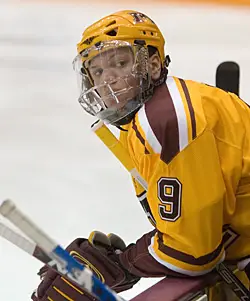
Minnesota will look for even more this season from Kyle Okposo (photo: Melissa Wade).
Minnesota
Head coach: Don Lucia, 21st season overall (485-261-66), ninth at Minnesota (220-96-29)
2006-07 record: 31-10-3 overall, 18-7-3 WCHA (39 points, first of 10 teams)
2006-07 team offense: 3.66 goals per game overall (third in NCAA), 3.25 conference (second)
2006-07 team defense: 2.30 goals per game overall (eighth), 2.39 conference (third)
2006-07 power play: 20.6% overall (seventh in NCAA), 20.3% conference (fourth)
2006-07 penalty kill: 83.3% overall (tied-24th), 81.5% conference (sixth)
Key returners: F Jay Barriball, so. (20-23-43), G Jeff Frazee, jr. (14-3-1, 2.35, .903 in 20 appearances), F Ben Gordon, sr. (12-19-31), F Kyle Okposo, so. (19-21-40), F Ryan Stoa, jr. (12-12-24), F Blake Wheeler, jr. (18-20-38)
Newcomers to watch: D Cade Fairchild (3-16-19 in 40 games for USNTDP), D Kevin Wehrs (8-32-40 in 57 games for Cedar Rapids/USHL), F Patrick White (18-31-49 in 30 games for Grand Rapids H.S.)
Early departures: D Alex Goligoski (9-30-39), D Erik Johnson (4-20-24), F Jim O’Brien (7-8-15)
Other key losses: G Kellen Briggs (17-7-2, 2.13, .917), D Mike Vannelli (10-29-39)
2007-08 predicted finish: Second
Bottom line: Basically, it’s the Gophers. They don’t rebuild; they reload, and this year should be no different. Lucia may say the question marks are on defense, but he should have his squad fighting for the MacNaughton Cup the whole season.
Denver
Head coach: George Gwozdecky, 22nd season overall (446-314-61), 14th at Denver (297-191-40)
2006-07 record: 21-15-4 overall, 13-11-4 WCHA (28 points, fourth of 10 teams)
2006-07 team offense: 2.67 goals per game overall (40th in NCAA), 2.61 conference (sixth)
2006-07 team defense: 2.38 goals per game overall (10th), 2.61 conference (fifth)
2006-07 power play: 16.3% overall (33rd in NCAA), 15.5% conference (eighth)
2006-07 penalty kill: 83.8% overall (22nd in NCAA), 79.8% conference (eighth)
Key returners: D Chris Butler, jr. (10-17-27), G Peter Mannino, sr. (8-6-2, 2.29, .919 in 18 appearances), F Rhett Rakhshani, so. (10-26-36), F Tyler Ruegsegger, so. (15-19-34), F Brock Trotter, so. (16-24-40)
Newcomers to watch: F Tyler Bozak (45-83-128 in 59 games for Victoria/BCHL), F Anthony Maiani (16-32-48 in 59 games for Sioux City/USHL), F Jesse Martin (19-37-56 in 59 games for Tri-City/USHL), F Kyle Ostrow (26-45-71 in 45 games for Nanaimo/BCHL)
Early departures: F Ryan Dingle (22-15-37), F Geoff Paukovich (8-19-17), D Keith Seabrook (2-11-13)
Other key losses: G Glenn Fisher (13-9-2, 2.32, .919), F/D Adrian Veideman (3-10-13)
2007-08 predicted finish: Third
Bottom line: Almost put Gwozdecky’s squad much lower, but one would have to think that hosting the Frozen Four in their backyard has to give the Pioneers a motivational edge. Plus, last year’s young D corps is a year older, which will help the team immensely.
Michigan Tech
Head coach: Jamie Russell, fifth season overall and at Michigan Tech (41-92-20)
2006-07 record: 18-17-5 overall, 11-12-5 WCHA (27 points, tied-sixth of 10 teams)
2006-07 team offense: 2.25 goals per game overall (53rd in NCAA), 2.46 conference (seventh)
2006-07 team defense: 2.17 goals per game overall (fifth), 2.29 conference (second)
2006-07 power play: 9.3% overall (57th in NCAA), 9.8% conference (tenth)
2006-07 penalty kill: 87.3% overall (fifth), 86.5% conference (first)
Key returners: D Geoff Kinrade, jr. (5-14-19), F Peter Rouleau, sr. (7-23-30), F Tyler Shelast, sr. (15-9-24), G Michael-Lee Teslak, jr. (11-8-3, 2.00, .916 in 22 appearances)
Newcomers to watch: F Jordan Baker (31-19-50 in 43 games for Olds/AJHL), D Deron Cousens (16-35-51 in 75 games for Penticton/BCHL), F Bennett Royer (32-44-76 in 56 games for Calgary/AJHL)
Early departures: None
Other key losses: D Lars Helminen (2-19-21), F Tyler Skworchinski (8-7-15)
2007-08 predicted finish: Fourth
Bottom line: The Huskies could use more offense, but they’re pretty much set defensively and in net. In other words, Michigan Tech’s stock should continue to rise.
Colorado College
Head coach: Scott Owens, ninth season overall and at Colorado College (195-109-24)
2006-07 record: 18-17-4 overall, 13-12-3 WCHA (29 points, fifth of 10 teams)
2006-07 team offense: 2.85 goals per game overall (31st in NCAA), 2.82 conference (fifth)
2006-07 team defense: 2.51 goals per game overall (15th), 2.64 conference (sixth)
2006-07 power play: 22.2% overall (fourth in NCAA), 23.5% conference (first)
2006-07 penalty kill: 87.1% overall (seventh), 85.2% conference (third)
Key returners: F Jimmy Kilpatrick, sr. (7-25-32), F Scott McCulloch, sr. (18-6-24), F Chad Rau, jr. (14-17-31), F Bill Sweatt, so. (9-17-26)
Newcomers to watch: F Tyler Johnson (29-21-50 in 20 games for Cloquet H.S.), G Tyler O’Brien (11-9-2, 2.80, .913 in 22 appearances for St. Paul’s Prep in N.H.), F Stephen Schultz (31-37-68 in 66 games for Lincoln/USHL), D Brett Wysopal (7-17-24 in 66 games for Tri-City/USHL)
Early departures: None
Other key losses: F Brandon Polich (4-15-19), D Lee Sweatt (9-15-24), G Matt Zaba (15-13-4, 2.39, .917)
2007-08 predicted finish: Fifth
Bottom line: CC has a lot of good things going for it and O’Connell should be an adequate replacement for Zaba. However, the closeness of the league will force the Tigers to claw their way into home ice … along with everyone else.
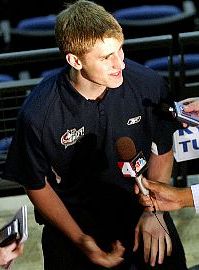
WCHA preseason Rookie of the Year Kyle Turris of Wisconsin meets the media at the NHL’s Top Prospects luncheon this summer (photo: Dave Sandford / Getty Images).
Wisconsin
Head coach: Mike Eaves, seventh season overall (116-97-23), sixth at Wisconsin (107-78-23)
2006-07 record: 19-18-4 overall, 12-13-3 WCHA (27 points, t-sixth of 10 teams)
2006-07 team offense: 2.27 goals per game overall (52nd in NCAA), 2.11 conference (tenth)
2006-07 team defense: 2.02 goals per game overall (fourth), 1.89 conference (first)
2006-07 power play: 14.9% overall (44th in NCAA), 16.1% conference (seventh)
2006-07 penalty kill: 86.1% overall (13th), 85.7% conference (second)
Key returners: G Shane Connelly, jr. (4-1-2, 1.11, .952 in seven appearances), F Michael Davies, so. (11-13-24), D Jamie McBain, so. (3-15-18), F Ben Street, jr. (10-7-17)
Newcomers to watch: D Ryan McDonagh (14-26-40 in 26 games for Cretin-Derham Hall), D Brendan Smith (12-36-48 in 39 games for St. Michael’s/OPJHL), F Kyle Turris (66-55-121 in 53 games for Burnaby/BCHL)
Early departures: D Joe Piskula (1-4-5), F Jack Skille (8-10-18)
Other key losses: F Ross Carlson (5-18-23), F Jake Dowell (19-6-25), G Brian Elliott (15-17-2, 2.10, .923), F Andrew Joudrey (9-20-29)
2007-08 predicted finish: Sixth
Bottom line: Shane Connelly will undoubtedly step up in goal for the Badgers; however, the lack of offensive firepower will hurt them more if he doesn’t.
St. Cloud State
Head coach: Bob Motzko, third season overall and at St. Cloud State (44-27-11)
2006-07 record: 22-11-7 overall, 14-7-7 WCHA (28 points, second of 10 teams)
2006-07 team offense: 3.17 goals per game overall (21st in NCAA), 3.18 conference (third)
2006-07 team defense: 2.48 goals per game overall (t-13th), 2.50 conference (fourth)
2006-07 power play: 18.3% overall (21st in NCAA), 18.8% conference (fifth)
2006-07 penalty kill: 80.4% overall (47th), 79.5% conference (tenth)
Key returners: F Nate Dey, sr. (10-22-32), F Ryan Lasch, so. (16-23-39), F Andreas Nodl, so. (18-28-46)
Newcomers to watch: D Brett Barta (8-29-37 in 58 games for Waterloo/USHL), G Dan Dunn (19-4-2, 1.94, .934 in 27 appearances for Wellington/OPJHL), F Tony Mosey (30-50-80 in 38 games for Salmon Arm/BCHL), F Brian Volpel (25-39-94 in 60 games for Salmon Arm/BCHL)
Early departures: F Andrew Gordon (22-23-45)
Other key losses: G Bobby Goepfert (17-10-7, 2.29, .924), F Dan Kronick (14-12-26)
2007-08 predicted finish: Seventh
Bottom line: The team gets some offense back in Nodl, Lasch and Dey, but the loss of Goepfert may prove to be too much to overcome, especially during the stretch run.
Minnesota State
Head coach: Troy Jutting, eighth season overall and at Minnesota State (108-129-34)
2006-07 record: 13-19-6 overall, 10-13-5 WCHA (25 points, eighth of 10 teams)
2006-07 team offense: 2.79 goals per game overall (33rd in NCAA), 2.89 conference (fourth)
2006-07 team defense: 3.47 goals per game overall (48th), 3.54 conference (ninth)
2006-07 power play: 18.2% overall (23rd in NCAA), 20.9% conference (third)
2006-07 penalty kill: 81.5% overall (38th), 79.1% conference (ninth)
Key returners: F Mick Berge, jr. (12-17-19), F Joel Hanson, sr. (15-13-28), F Jon Kalinski, jr. (17-10-27), G Mike Zacharias, jr. (10-9-6, 3.07, .892 in 25 appearances)
Newcomers to watch: D Channing Boe (1-7-8 in 58 games for Green Bay/USHL), D Kurt Davis (8-27-35 in 58 games for Green Bay/USHL), D Ben Youds (10-32-42 in 61 games for Shattuck-St. Mary’s prep school)
Early departures: D Steve Wagner (6-23-29)
Other key losses: F Travis Morin (17-22-39)
2007-08 predicted finish: Eighth
Bottom line: Though the team could use some more offense, the biggest question for the Mavericks is defense. However, they are one of the few teams with both netminders returning.
Minnesota-Duluth
Head coach: Scott Sandelin, eighth season overall and at Minnesota-Duluth (109-143-31)
2006-07 record: 13-21-5 overall, 8-16-4 WCHA (20 points, ninth of 10 teams)
2006-07 team offense: 2.64 goals per game overall (40th in NCAA), 2.29 conference (eighth)
2006-07 team defense: 3.10 goals per game overall (36th), 3.00 conference (eighth)
2006-07 power play: 21.4% overall (6th in NCAA), 17.7% conference (sixth)
2006-07 penalty kill: 84.6% overall (20th), 82.6% conference (fourth)
Key returners: F Michael Gergen, jr. (5-11-16), D Josh Meyers, jr. (11-13-24), G Alex Stalock, so. (5-14-3, 3.34, .881 in 23 appearances)
Newcomers to watch: F Justin Fontaine (30-41-71 in 52 games for Bonnyville/AJHL), D Evan Oberg (9-14-23 in 52 games for Camrose/AJHL), G Kenny Reiter (22-7-4, 2.69, .926 in 34 appearances for Fairbanks/NAHL), F Kyle Schmidt (46-33-79 in 62 games for Fairbanks/NAHL)
Early departures: D Matt Niskanen (9-22-31), F Mason Raymond (14-32-46)
Other key losses: G Josh Johnson (8-7-2, 2.14, .922), F Bryan McGregor (16-12-28)
2007-08 predicted finish: Ninth
Bottom line: Alex Stalock will probably get the starting job in net, but the Bulldogs still have too many questions up front. However, relying on a balanced offense may be just what the doctor ordered for this team.
Alaska-Anchorage
Head coach: Dave Shyiak, third season overall and at Alaska-Anchorage (19-48-6)
2006-07 record: 13-21-3 overall, 8-19-1 WCHA (17 points; 10th of 10 teams)
2006-07 team offense: 2.43 goals per game overall (49th in NCAA), 2.21 conference (ninth in WCHA)
2006-07 team defense: 3.35 goals per game overall (45th), 3.61 conference (tenth)
2006-07 power play: 14.4% overall (48th), 12.8% conference (ninth)
2006-07 penalty kill: 81.7% overall (36th), 80.9% conference (seventh)
Key returners: F Paul Crowder, so. (11-13-24); F Josh Lundin, so. (11-9-20), G Jon Olthius, so. (3-6-1, 3.59, .886)
Newcomers to watch: G Matthew Gordon (28-20-0, 3.08, .905 in 51 appearances for Burnaby/BCHL), D Kane Lafranchise (12-23-35 in 58 games for Spruce Grove/AJHL), F Craig Parkinson (42-37-79 in 55 games for Cowichan Valley/BCHL)
Early departures: F Jay Beagle (10-10-20), G Nathan Lawson (10-15-2, 3.03, .893)
Other key losses: F Justin Bourne (10-21-31)
2007-08 predicted finish: 10th
Bottom line: The Seawolves are improving bit by bit each year, but they’re not quite ready to completely crawl out of the cellar.

